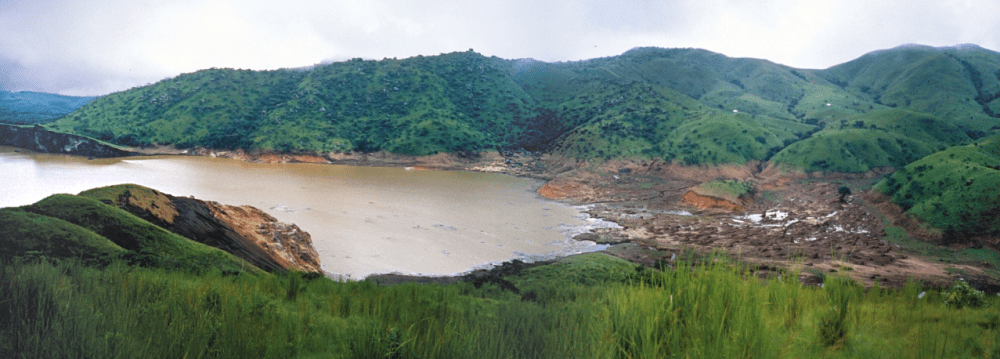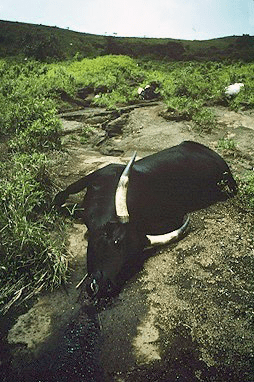On August 21, 1986, tragedy struck Cameroon as Lake Nyos exploded killing thousands of people and wildlife for miles around. The eruption was driven by a surge of deadly gas that, having been released from the Earth’s mantle, had been building up at the bottom of the lake for hundreds of years.
A rockslide within the lake, landslide, or volcanic activity may have been to blame for finally setting it free as a sudden disturbance of the lake facilitated the release of 1.24 million tonnes of carbon dioxide (CO2). The catastrophic emission suffocated people in the vicinity as the gas causes asphyxiation by hypoxia as well as being toxic. In such high concentrations, CO2 can knock a person out instantly and can stop them from being able to breathe within a minute.
First-person accounts from the disaster shared by survivors to the Smithsonian Magazine talk of how the explosion began with a rumbling shortly after which frothy spray burst hundreds of feet into the air and a gust blew through homes in the local village. The gas killed thousands of people and swathes of wildlife and livestock, and an enormous white cloud formed over the water.
Unfortunately, the devastation didn’t stop there. The heavy cloud sunk into a valley and made its way to nearby settlements 15.5 miles (25 kilometers) away from the site of the explosion causing asphyxiation and death wherever it went. Only those on high ground were able to avoid it.
Desperate to understand how such a tragedy could unfold, scientists from across the globe joined forces in Cameroon to conduct investigations on the crater lake. They revealed that Nyos, along with another crater lake nearby, were both unusual in that they contained CO2-rich layers at the bottom indicating that there was a continuous gradual leak into the water.

A photo of the exploding Lake Nyos eight days after the deadly eruption. Image credit: United States Geological Survey
We now know that the Cameroon Volcanic Line is home to 43 deep crater lakes like this, all of which have the potential to contain deadly volumes of toxic gas. Elsewhere in the globe, similar lakes can be found in Italy, Tanzania, and on the border of Rwanda.
The weight of the water kept it at bay until a disturbance rumbled the waters in such a way that the gas was suddenly belched into the air. A similar explosion had occurred at Lake Manoun two years before the 1986 disaster, though not on the same scale.
The lakes can be managed with pipes that provide an escape for the gas so that it can be released into the atmosphere slowly, rather than in one gigantic eruption. However, scientists fear that this may not be enough to prevent future disasters.
Writing for The Conversation, Disaster Management Scholar, researcher, and educator, Henry Ngenyam Bang of Bournemouth University has shared concerns that a similar disaster may be brewing at Lake Kuk, also in Cameroon. Its waters have turned from blue to a dull red, something that was seen in Lake Nyos before the explosion.
To prevent further loss of life, Bang’s recommendations are that the lakes in the region be tested again with initial checks for most bodies of water in the Cameroon Volcanic Line having taken place over three decades ago. Indicators like thermal profile (how temperature changes with depth), concentration of dissolved gases, surface area, water volume, and depth can all be used to assess a lake’s likelihood of holding massive CO2 deposits.

A cow killed by the CO2 released when Lake Nyos exploded. Image credit: Photo by Jack Lockwood of the US Geological Survey, Public Domain
While testing for these would be logistically challenging, says Bang, keeping on top of monitoring is the only way to prepare for and prevent future lake explosions. While the changing conditions at Kuk are currently being tacked up to rainfall, he urges that its placement along the Cameroon Volcanic Line means a gas leak could strike at any time.
Another protective tool could be to place CO2 detectors near worrisome lakes like Kuk and Nyos so that changing conditions could be detected and actioned as and when they occur. Equipping these with alarms could warn people living nearby to head for higher ground where heavy CO2 struggles to reach.
“The Directorate of Civil Protection is the designated agency responsible for coordinating disaster risk management in Cameroon,” concluded Bang. “The agency should liaise with other stakeholders in the government and private sector to ensure the safety of Cameroon’s dangerous lakes. If the authorities are not proactive, the Lake Nyos disaster scenario may repeat where thousands of people and livestock are suddenly killed.”
Source Link: Lakes Can Explode And Kill Thousands Of People In An Instant, Now Scientists Are Worried About One In Particular